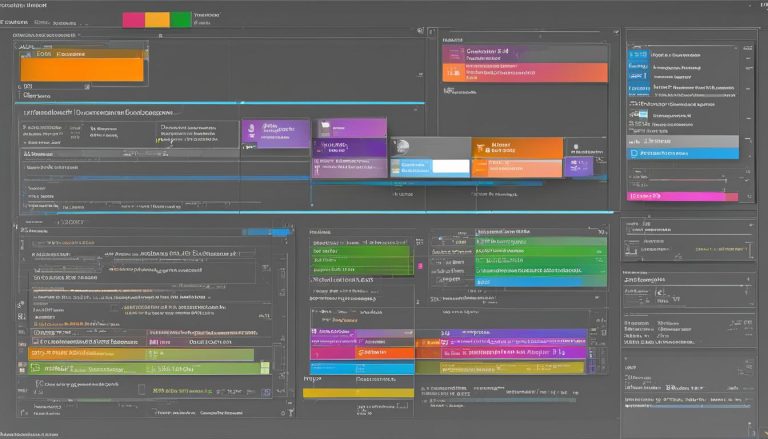Software testing is an integral part of the software development process, ensuring that the final product meets quality standards. One crucial aspect of software testing is functionality testing, which focuses on checking if the software’s features are working as intended and aligned with the specified requirements.
Functional testing is the cornerstone of software quality assurance, as it verifies that the software performs its intended functions without delving into the internal code structure. This type of testing is commonly used across various industries and forms the basis of software development.
Key Takeaways:
- Functionality testing ensures that the software’s features work as expected.
- It focuses on the software’s external behavior and functionality, not the internal code structure.
- Functional testing is crucial for software quality assurance.
- Common types of functional testing include unit testing, component testing, integration testing, and system testing.
- Functional testing enhances communication between analysts, developers, and testers, leading to faster development and improved project progress.
Examples of Functional Testing
Functional testing is an essential part of software testing that ensures the proper functioning of a system’s features according to the specified requirements. Let’s explore some examples of functional testing to understand how it is applied in practical scenarios.
Example 1: Web Application User Login
When testing a web application that requires user login, functional testing involves checking various aspects to ensure the login page functions correctly. This includes verifying user authentication, account lockout, password reset, remember me feature, account recovery, multi-factor authentication, and session management. By thoroughly testing these functionalities, we can ensure that user login is secure, seamless, and meets the user’s expectations.
Example 2: eCommerce Website
For eCommerce websites, functional testing is crucial to ensure a seamless user experience. It involves testing the product search functionality to ensure accurate and relevant search results are displayed. Additionally, functional testing checks the shopping cart functionality to validate that users can add and remove items, view their cart contents, and proceed to the checkout process smoothly. By conducting thorough functional testing, eCommerce websites can deliver a reliable and user-friendly shopping experience to their customers.
| Functional Testing Examples |
|---|
| User Login |
| Web Application |
| eCommerce Website |
By implementing functional testing in these examples and other software testing scenarios, we can ensure that the software’s features work as intended and provide a satisfactory user experience.
Functional Testing vs Non-functional Testing: Key Differences
Functional testing and non-functional testing are two distinct types of software testing that serve different purposes. Understanding the differences between these two types can help organizations better plan their testing strategies and ensure the overall quality of their software.
Functional testing focuses on verifying if the software functions as intended and meets the specified functional requirements. It involves testing the individual features and functionalities of the software to ensure they work correctly. This type of testing is concerned with validating that the software performs its intended tasks and delivers the expected results.
On the other hand, non-functional testing evaluates the non-functional attributes of the software, such as performance, reliability, usability, and security. It assesses how well the software performs under different conditions and measures its overall quality from a user’s perspective. Non-functional testing aims to ensure that the software not only functions correctly but also meets the expected standards in terms of performance and user experience.
While functional testing primarily focuses on the software’s behavior and adherence to functional requirements, non-functional testing examines the software’s performance in areas that go beyond its core functionalities. Both types of testing are crucial in the software development process to ensure the reliability, effectiveness, and quality of the software product.
Key Differences between Functional Testing and Non-functional Testing:
| Functional Testing | Non-functional Testing |
|---|---|
| Verifies if the software functions as intended | Evaluates non-functional attributes like performance, reliability, and usability |
| Checks if individual features and functionalities work correctly | Focuses on overall quality and user experience |
| Ensures the software meets functional requirements | Assesses how well the software performs under different conditions |
By understanding the differences between functional testing and non-functional testing, organizations can develop comprehensive testing strategies that address both the software’s core functionalities and its overall quality. This ensures that the software not only performs its intended tasks but also meets user expectations in terms of performance, reliability, usability, and security.
Types of Functional Testing and Examples
Functional testing encompasses various types of testing that are crucial in ensuring the software’s functionality and meeting the specified requirements. Each type of functional testing serves a specific purpose in the software development process. Here are some common types of functional testing:
- Unit Testing: This type of testing focuses on testing individual units or components of code to validate their functionality. It helps identify defects or errors at a granular level, ensuring that each unit performs as expected.
- Component Testing: Component testing involves testing individual modules or components to verify their expected output. It ensures that each component functions correctly and integrates seamlessly with other components.
- Integration Testing: Integration testing examines the interaction between different components to ensure they function correctly when integrated. It helps uncover any issues that may arise during the integration process, ensuring the software works as a cohesive unit.
- System Testing: System testing tests the complete, integrated system to ensure that all business and functional requirements are met. It validates the software’s functionality from end to end, simulating real-world usage scenarios.
These types of functional testing play a crucial role in uncovering defects or issues in the software, ensuring that it performs as intended and meets user expectations. Let’s explore some examples of functional testing:
“Unit testing is like building with Lego blocks, checking each piece’s functionality before assembling them together.”
For example, when testing a web application that requires user login, functional testing involves checking if the login page functions correctly by verifying user authentication, account lockout, password reset, remember me feature, account recovery, multi-factor authentication, and session management. Another example is functional testing for eCommerce websites, which includes testing the product search functionality, shopping cart functionality, and checkout process.
| Type of Functional Testing | Description | Example |
|---|---|---|
| Unit Testing | Testing individual units or components of code | Testing a specific function within a software module |
| Component Testing | Testing individual modules or components | Verifying the functionality of a login form |
| Integration Testing | Testing the interaction between different components | Ensuring data transfer between modules works correctly |
| System Testing | Testing the complete, integrated system | Verifying end-to-end functionality of a web application |
These examples demonstrate the importance of functional testing in ensuring that the software functions as intended and meets user requirements. By conducting thorough functional testing, organizations can deliver high-quality software that provides a seamless user experience.
The Significance of Functional Software Testing
Functional software testing plays a vital role in ensuring that the software’s functions align with the specified requirements. It helps verify that the software performs routine tasks accurately and delivers the expected results. Functional testing is crucial in the software development process as it ensures the reliability and effectiveness of the product. It also enhances communication between analysts, developers, and testers, leading to improved project progress and faster development.
Benefits of Functional Software Testing
- Identification of defects: By performing functional testing, potential defects can be identified early in the development cycle, preventing them from causing major issues in the later stages.
- Validation of user requirements: Functional testing ensures that the software fulfills the specified functional requirements, meeting the needs and expectations of the end-users.
- Enhanced software quality: By thoroughly testing the software’s functionality, the overall quality of the product is improved, resulting in a more reliable and efficient system.
- Reduced business risks: Functional testing helps mitigate business risks associated with software failures by ensuring that the software functions as intended.
- Improved user experience: By verifying the software’s functions, functional testing helps deliver a seamless and intuitive user experience, contributing to user satisfaction and customer loyalty.
Functional software testing ensures that the software meets the specified requirements and performs its intended functions accurately. It is a crucial step in the software development process, helping to enhance the quality, reliability, and effectiveness of the product.
The Significance of Non-Functional Software Testing
Non-functional software testing, also known as quality assurance testing, is a critical aspect of software development that goes beyond the core functionalities of a software product. While functional testing ensures that the software functions as intended, non-functional testing evaluates the overall quality, performance, and user experience of the software. By conducting thorough non-functional testing, organizations can ensure that their software meets user expectations and performs well under different circumstances.
One of the key reasons why non-functional software testing is significant is because it assesses the performance of the software in real-world scenarios. This includes evaluating factors such as response time, scalability, and reliability. By testing the software for its performance capabilities, organizations can identify and address any bottlenecks or performance issues that may arise during usage. This helps in delivering a high-quality software product that offers a seamless user experience.
“Non-functional testing is crucial for ensuring that the software not only meets the functional requirements but also satisfies other important aspects such as security, usability, and accessibility. By thoroughly evaluating these aspects, organizations can ensure that their software is reliable, secure, and easy to use for end-users.”
In addition to performance, non-functional testing also focuses on security testing to identify any vulnerabilities in the software. This includes testing for potential threats such as data breaches or unauthorized access. By conducting comprehensive security testing, organizations can mitigate these risks and protect sensitive user data.
Overall, non-functional software testing plays a crucial role in ensuring the overall quality and effectiveness of a software product. By evaluating performance, security, usability, and other non-functional attributes, organizations can deliver software that meets user needs, enhances user satisfaction, and maintains their reputation in the market.
Table: Key Aspects of Non-Functional Software Testing
| Aspect | Description |
|---|---|
| Performance testing | Evaluates the software’s ability to perform under different load conditions and measures factors such as response time, scalability, and stability. |
| Security testing | Identifies potential vulnerabilities in the software and assesses its ability to protect sensitive user data against unauthorized access or data breaches. |
| Usability testing | Evaluates the user-friendliness and intuitiveness of the software, ensuring that it is easy to navigate, understand, and use for end-users. |
| Compatibility testing | Verifies that the software functions correctly on different devices, operating systems, and browsers, ensuring a consistent user experience. |
| Accessibility testing | Ensures that the software can be accessed and used by individuals with disabilities, complying with accessibility standards and guidelines. |
Conclusion
In conclusion, functionality testing is a crucial aspect of software testing that ensures the software’s functions align with the specified requirements. By verifying if the software performs its intended functions, functional testing forms the foundation of software quality assurance. It focuses on checking the features of a system and does not concern itself with the internal code structure.
Non-functional testing, on the other hand, goes beyond the core functionalities of the software and evaluates its overall quality, performance, and user experience. It assesses aspects such as performance, security, and usability to ensure that the software meets user expectations and performs well under different circumstances.
Both functional and non-functional testing are essential in the software development process to ensure the reliability, effectiveness, and quality of the software product. By conducting thorough testing, organizations can deliver high-quality software that meets user needs and expectations. Therefore, the importance of functionality testing and non-functional testing cannot be overstated in the context of software development and quality assurance.
FAQ
What is functionality testing?
Functionality testing is a crucial aspect of software testing that focuses on checking if the features of a system are working as expected according to the specified requirements.
What does functionality testing entail?
Functionality testing ensures that the software performs its intended functions and does not concern itself with the internal code structure.
What are some examples of functional testing?
Functional testing examples include testing login functionality, product search functionality, shopping cart functionality, and checkout process in web applications and eCommerce websites.
How is functional testing different from non-functional testing?
Functional testing focuses on verifying if the software functions as intended and meets the specified functional requirements, while non-functional testing evaluates non-functional attributes such as performance and usability.
What are the different types of functional testing?
Some common types of functional testing include unit testing, component testing, integration testing, and system testing.
Why is functional software testing significant?
Functional software testing plays a vital role in ensuring that the software’s functions align with the specified requirements, enhances the overall user experience, and ensures the reliability and effectiveness of the product.
Why is non-functional software testing important?
Non-functional software testing evaluates the overall quality, performance, and user experience of the software, ensuring that it is not only functional but also reliable and provides a seamless user experience.
Janina is a senior specialist in information technology


